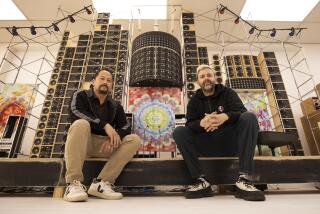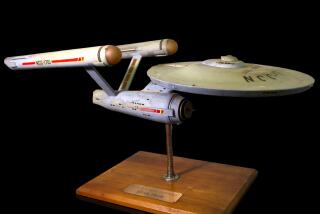Foreign Exchange
- Share via
In its final upheaval, the Union of Soviet Socialist Republics went from evil empire to easygoing garage sale.
And as Warsaw Pact profiteers met American entrepreneurs, their desperation for dollars collided with our instincts for collectibles.
Suddenly, surplus MiG-15 fighters were disarmed and disassembled, resold and restored. And reassigned to the friendlier skies of Arizona and California.
Peter the Great Coat Co. in Minneapolis is selling jackets worn by Moscow street sweepers. A Northridge man can put you behind the khaki wheel of a Czech military truck. The MiG-15s (and 17s) are available from firms in Phoenix and Chino.
And Cosmonaut space suits, KGB identification cards, flags from Red October submarines and East German fur hats still warm from the Cold War are surfacing at stalls and stores from Manhattan’s 26th Street flea market to the Rose Bowl.
Even the august Kremlin, abetted by Russia’s Ministry of Diamonds, Gold and Silver, continues to shovel .857 pure Soviet silverware by the ton to eager American dealers and buyers fascinated by the trappings, trash and treasures of a former enemy.
“We buy sight unseen and by the kilogram,” says Mitch Siegler, partnered with wife Elizabeth in the Sovietski Collection of San Diego. Their catalog is subtitled “distinctive timepieces, optics, gifts and collectibles from a bygone era,” which translates to a back street warehouse bulging with expensive Soviet tchotchkes and affordable CCCP kitsch. “[Moscow dealers] say: ‘Look, we got 300 kilos of silver, don’t know what it is, do you want it or not?’ ”
So the Sieglers are shipped dusty, often corroded classics from World War II vaults. Such as czarina tea-glass holders, silver vodka cups from long-forgotten state dinners, and spoons enameled at a factory that once handled works of Carl Faberge.
They also get bummers.
“Like a single bowl, or a plate with Vietnamese markings on the bottom, and tea strainers we can’t put in the catalog because we only received two,” says Mitch Siegler, 36, an Anheuser-Busch finance and operations specialist before opening this East-West import-export business five years ago.
Much of what the Sieglers sell is authentic with undeniable histories. Brass, mahogany-boxed compasses and gimbaled chronometers have paperwork proving they came from decommissioned battleships. Hammer and sickle plaques were indeed on Kremlin entrances and first-class railroad cars because they arrived in San Diego thick with 16 coats of ancient paint. And their scuffed, slightly weary Doomsday Clocks definitely flew aboard TU-16 Bear bombers, and would have timed nuclear free falls had history and the superpowers twitched the wrong way.
*
Yet some products, the Sieglers admit, are commercial shams at worst, shameless reproductions at best.
Example: No KGB spy would have survived his first hour undercover while wearing a KGB crested wrist watch. It’s a commemorative made principally for those known to work Moscow singles bars. Nor were agents issued KGB hip flasks in lieu of winter woollies. And although an advertised bulkhead clock is jeweled, tough, eight-day and manufactured by the Vostok Military Clock Factory, suppliers to the Soviet navy, it’s a modern copy and a tarted-up, limited edition of a real submarine timepiece.
“But there are a couple of things the Russians do well, and on a level with anyone in the world,” Mitch says. “Timepieces and opticals. And clocks and binoculars they made for the military, they made right, even using Swiss and United States tooling sent them during World War II.”
So, claims Mitch, his 15-power border-guard observation binoculars with wide-angle, 110-millimeter objective lenses and optimum edge-to-edge image definition, are a steal at $2,750 (including tripod)--the most expensive item in his catalog.
They have been a hot buy, he says, for Hale-Bopp watchers.
Black leather flying helmets--complete with throat microphones and oxygen masks--sell well to pilots of vintage cars and antique airplanes. Mitch obtained five MiG-pilot flight suits, wondered if they would move, and promptly sold all five, mostly to aerospace companies using them on mannequins as lobby displays.
And CEOs have been ordering Spetznaz Special Forces machetes--as gallows humor gifts to executive teams responsible for downsizing and hacking ways through corporate jungles.
*
Elizabeth Siegler sees the window of Soviet opportunity yawning wide for “products with legs, like timepieces, binoculars and telescopes bought not for their historical value, but because they are good products.”
But with Kremlin silver an exhaustible supply and elaborately embroidered five-year plan banners unlikely to be replicated, all good Soviet things must come to an end.
So Elizabeth and Mitch have been exploring other possibilities. What of Stalin memorabilia that might have escaped the purge? Communist propaganda posters from the ‘40s and ‘50s? Or statues and busts of Lenin that at one time were raised in every city, town and hamlet in the USSR?
“We’re going to look into it,” Elizabeth says.
But not, she promises, the possibility of buying the well-mummified Lenin.
More to Read
Sign up for Essential California
The most important California stories and recommendations in your inbox every morning.
You may occasionally receive promotional content from the Los Angeles Times.










